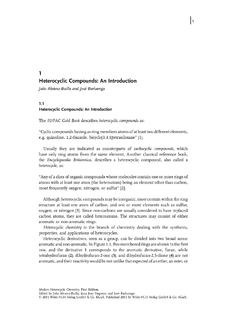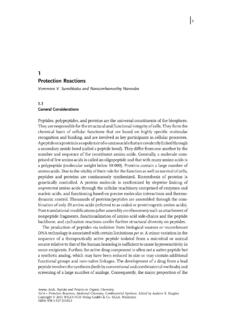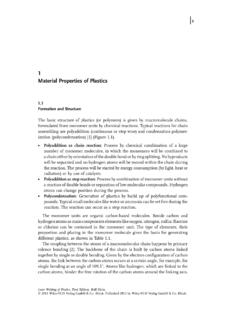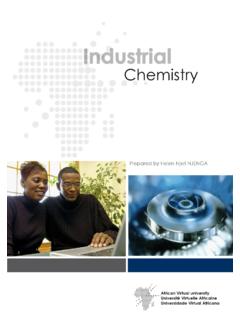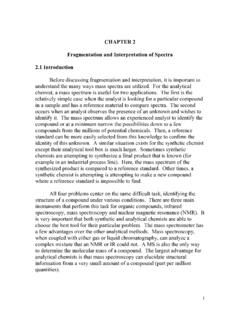Transcription of 1 Introduction to Catalysis - Wiley-VCH
1 Ask the average person in the street what a catalyst is, and he or she will probablytell you that a catalyst is what one has under the car to clean up the exhaust. Indeed,the automotive exhaust converter represents a very successful application of cataly-sis; it does a great job in removing most of the pollutants from the exhaust leavingthe engines of cars. However, Catalysis has a much wider scope of application thanabating example, living matter relies on enzymes, which are the most specific cata-lysts one can think of.
2 Also, the chemical industry cannot exist without Catalysis ,which is an indispensable tool in the production of bulk chemicals, fine chemicalsand scientists and engineers Catalysis is a tremendously challenging, highly multi-disciplinary field. Let us first see what Catalysis is, and then why it is so importantfor to CatalysisCatalysis in IndustryCatalysts are the workhorses of chemical transformations in the 85 90 % of the products of chemical industry are made in cata-lytic processes. Catalysts are indispensable of transportation fuels in one of the approximately 440 oil refi-neries all over the of bulk and fine chemicals in all branches of chemical of pollution by avoiding formation of waste (unwanted byproducts).
3 Abatement of pollution in end-of-pipe solutions (automotive and industrialexhaust).A catalyst offers an alternative, energetically favorable mechanism to the non-catalytic reaction, thus enabling processes to be carried out under industriallyfeasible conditions of pressure and of Modern Catalysis and Kinetics, Second Edition. I. Chorkendorff, J. W. NiemantsverdrietCopyright 2007 Wiley-VCH Verlag GmbH&Co. KGaA, WeinheimISBN: is Catalysis ?A catalyst accelerates a chemical reaction. It does so by forming bonds with thereacting molecules, and by allowing these to react to a product, which detaches fromthe catalyst, and leaves it unaltered such that it is available for the next reaction.
4 Infact, we can describe the catalytic reaction as a cyclic event in which the catalystparticipates and is recovered in its original form at the end of the us consider the catalytic reaction between two molecules A and B to give aproduct P, see Fig. The cycle starts with the bonding of molecules A and B tothe catalyst. A and B then react within this complex to give a product P, which isalso bound to the catalyst. In the final step, P separates from the catalyst, thus leav-ing the reaction cycle in its original catalyst catalyst PPABF igure catalytic reaction is a sequence of elementary steps,in which reactant molecules bind to the catalyst, where they react, afterwhich the product detaches from the catalyst, liberating the latter for thenext see how the catalyst accelerates the reaction, we need to look at the potentialenergy diagram in Fig.
5 , which compares the non-catalytic and the catalytic reac-tion. For the non-catalytic reaction, the figure is simply the familiar way to visualizethe Arrhenius equation: the reaction proceeds when A and B collide with sufficientenergy to overcome the activation barrier in Fig. The change in Gibbs freeenergy between the reactants, A + B, and the product P catalytic reaction starts by bonding of the reactants A and B to the catalyst, ina spontaneous reaction. Hence, the formation of this complex is exothermic, andthe free energy is lowered.
6 There then follows the reaction between A and B whilethey are bound to the catalyst. This step is associated with an activation energy; how-ever, it is significantly lower than that for the uncatalyzed reaction. Finally, the prod-uct P separates from the catalyst in an endothermic Introduction to Catalysis3bonding reaction separationreaction coordinate+ABcatalyst catalyst ABcatalyst Pcatalyst PABP potential energyFigure energy diagram of a heterogeneous catalyticreaction, with gaseous reactants and products and a solid catalyst.
7 Notethat the uncatalyzed reaction has to overcome a substantial energybarrier, whereas the barriers in the catalytic route are much energy diagram of Fig. illustrates several important points:.The catalyst offers an alternative path for the reaction, which is obviously morecomplex, but energetically much more activation energy of the catalytic reaction is significantly smaller than that ofthe uncatalyzed reaction; hence, the rate of the catalytic reaction is much larger(we explain this in greater detail in Chapter 2).
8 The overall change in free energy for the catalytic reaction equals that of the unca-talyzed reaction. Hence, the catalyst does not affect the equilibrium constant forthe overall reaction of A + B to P. Thus, if a reaction is thermodynamically unfa-vorable, a catalyst cannot change this situation. A catalyst changes the kineticsbutnotthe catalyst accelerates both the forward and the reverse reaction to the sameextent. In other words, if a catalyst accelerates the formation of the product Pfrom A and B, it will do the same for the decomposition of P into A and far it is immediately evident that there are also cases in which the combina-tion of catalyst with reactants or products will not be successful.
9 If the bonding between reactants and catalyst is too weak, there will be hardly anyconversion of A and B into if the bond between the catalyst and one of the reactants, say A, is toostrong, the catalyst will be mostly occupied with species A, and B is not availableto form the product. If A and B both form strong bonds with the catalyst, theintermediate situation with A or B on the catalyst may be so stable that reactionbecomes unlikely. In terms of Fig. , the second level lies so deep that the What is Catalysis ?41 Introduction to Catalysistion energy to form P on the catalyst becomes too high.
10 The catalyst is said to bepoisoned by (one of) the the same way, the product P may be too strongly bound to the catalyst for sepa-ration to occur. In this case the product poisons the , we intuitively feel that the successful combination of catalyst and reactionis that in which the interaction between catalyst and reacting species is not tooweak, but also not too strong. This is a loosely formulated version of Sabatier s Prin-ciple, which we encounter in a more precise form in Chapter 2 and in detail in Sec-tion now, the catalyst has been an unspecified, abstract body, so let us first lookat what kind of catalysts Can Be Atoms, Molecules, Enzymes and Solid SurfacesCatalysts come in a multitude of forms, varying from atoms and molecules to largestructures such as zeolites or enzymes.


